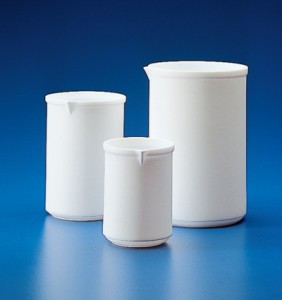Process Name:
HNA01
Author:
Mark Bachman, Winter 2000. Adapted for AMPEL ANF by M. Beaudoin, April 2014.
Overview:
HNA (hydrofluoric, nitric, acetic) is an extremely aggressive acidic mixture which will vigorously attack silicon. It is an isotropic wet etchant which etches silicon at a rate of approximately 1-3 microns per minute (using the formula in this document). This is a dangerous wetbench process and requires qualification for dangerous wetbench processes. The use of dangerous chemicals requires that the user may not perform the process alone.
Time Needed:
The HNA process takes typically 15 minutes, depending on depth of etch.
Materials Needed:
- Silicon wafer with a nitride hard mask
- Hydrofluoric acid
- Acetic acid
- Nitric acid
- Polypropylene container
Preparation:
The HNA mixture is a dangerous chemical and protective gear must be worn when using it, in particular, apron, acid (orange) gloves and eye protection, including full face shield, must be worn. Don protective gear and work only in the wetbench. If an HNA mixture* is not available, you can prepare a fresh mixture in the following manner. Measure 160 ml of acetic acid into a polypropylene or other safe plastic container. Do not use a glass container! Add 60 ml of nitric acid to the acetic acid. Then add 20 ml of hydrofluoric acid (HF) to the mixture. Label the container “HNA etchant—extremely dangerous!”, then add your name, the list of chemicals, the date, and information that states poison and extremely corrosive.
- 160 ml acetic acid
- 60 ml nitric acid
- 20 ml hydrofluoric acid
Make sure the wafer to etch has a nitride hard mask patterned on it, that silicon regions are exposed, and that the backside is protected with nitride. Also, make sure there is no photoresist still on the wafer. If so, rinse the wafer with acetone to remove the remaining photoresist. Rinse with isopropanal and DI water, then blow dry.
*There are many variations in the ratio of the three acids which can be used to make HNA. Other ratios will produce different etch rates and roughnesses. See Kern and Vossen for more details.
Procedure:
Carefully place the wafer in the HNA mixture. The solution will start vigorously bubbling at the exposed silicon sites. Leave the container open to allow the nitric fumes to escape. The mixture may turn slightly brown during the etch, but this is normal. Gently move the wafer around to dislodge bubbles while etching. The etch rate for this mixture is approximately 1-3 microns per minute at room temperature. It is strongly recommended that you remove the wafer from the etchant in time to check the etch depth before proceeding.
Cleanup:
Store the HNA in a clearly labeled polypropylene container, such as the one used for etching. When the etchant has been depleted, dispose in the specially marked waste container dedicated to HF waste. Be sure to document on the waste label. Wash all areas, containers, gloves, and tools with DI water.
Safety & Emergency:
All ANF safety and procedural regulations must be followed. Hydrofluoric acid (HF) is an extemely toxic and dangerous acid. Use of HF requires at least one other person in the clean room (buddy system). HF should be handled in a laminar flow bench, using nitrile gloves inside the acid (orange) gloves, apron, eye protection and full face shield. Any small spills should be wiped up immediately with wipes and rinsed. Rinse the wipes with lots of DI water and dispose of in the waste can. NEVER LEAVE the etchant unattended.
In case of exposure to HF Seek medical attention immediately! For skin exposure, flush immediately with water for 5 minutes followed by liberal application of calcium gluconate gel to the skin. Remove all clothing that are exposed before and while flushing with water. For eye exposure, flush the eyes with water three times, 5 minutes each. Irrigate the eye repeatedly with 500-1000 ml of a 1% calcium gluconate solution applied through a syringe. Call for prompt emergency room transport. Apply ice-water compresses during transport. In case of large spill, EVACUATE THE CLEANROOMS IMMEDIATELY and activate the evacuation alarm.
References:
- G. T. A. Kovac, Micromachined Transducers Sourcebook, McGraw-Hill: New York, 1998, Ch. 2.
- W. Kern and J. Vossen, Thin Film Processes, Academic Press: New York, 1978, Ch V-1.
- Northwestern University Office of Research Safety (ORS) safety documents, http://www.northwestern.edu/research-safety/index.htm.
The following checklist is designed to aid the researcher when performing this process.
- Substrate must be clean with hard nitride mask. No photoresist.
- Don neoprene gloves and eye protection.
- Prepare HNA solution: 160 ml acetic acid, 60 ml nitric acid, 20 ml hydrofluoric acid.
- Label container.
- Soak wafer in etchant. Don’t cover.
- Etch rate is about 1-3 microns/minute.
- Remove early, DI rinse / blow dry. Check on profilometer.
- Clean up, dispose wastes in special waste containers.
